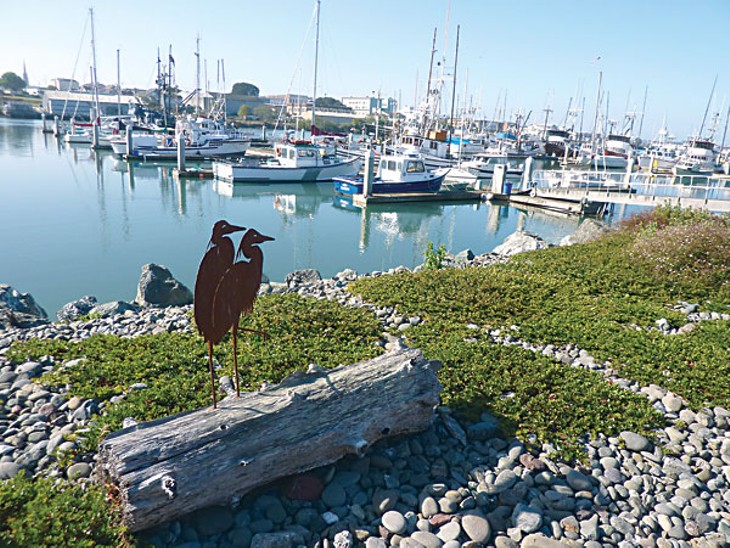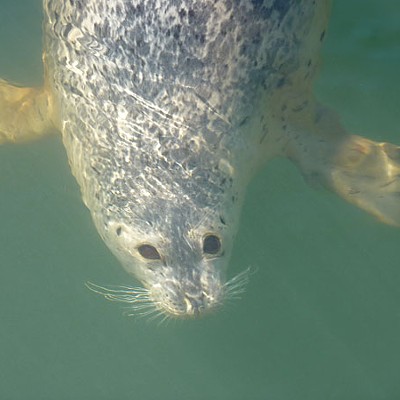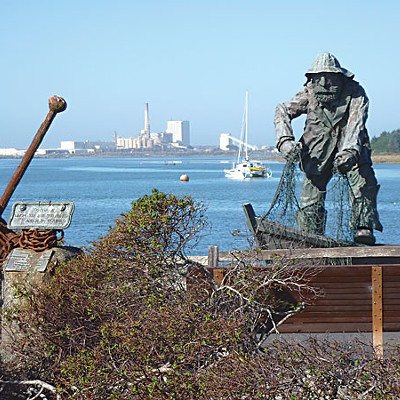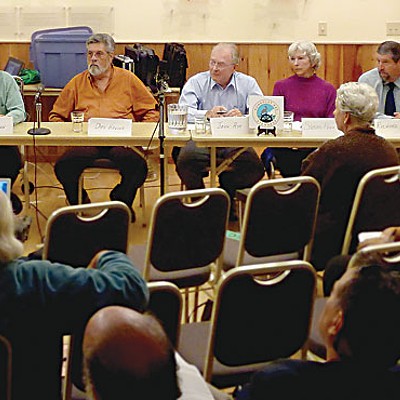Humboldt Bay is having an identity crisis. Poor thing's feeling insecure and, frankly, a bit depressed. (Peek into her wallet and you can understand why.) The grand sense of purpose she possessed back when trees and fish seemed inexhaustible and the mighty railroad kept her company has grown murky and diluted (though the water itself is clearer these days). The the pulp mill sits idle on her shore; the fishing industry struggles through various forms of jeopardy; and the rail through the Eel River Canyon lies in shambles.
Enter the Humboldt Bay Harbor, Recreation and Conservation District, whose commissioners serve as chaperones, trying to steer the bay toward a brighter future. There are at least two things this year's batch of candidates agree on: First, there's immense potential for our bay, which remains the largest natural coastal harbor between San Francisco and Seattle. Second, that potential is not being met. Beyond that their visions diverge. Should the district hold to its long-established -- albeit ever more challenging -- plan to transform the bay into an international shipping hub? Or is it time to abandon that dream and focus instead on smaller goals like short sea shipping, expanded recreation opportunities and finally building a trail around the bay?
Intermingled in this larger debate are several messy issues -- like money, for one. Drastic cuts to the district's $3.5 million budget earlier this year only partially allayed fears of impending bankruptcy. Some candidates, noting the absence of customers requiring deep-port services, have questioned both the economic and ecologic wisdom of continuing to dredge 1.5 million cubic yards of sediment from the bay annually at a cost of roughly $5.6 million (courtesy the Army Corps of Engineers). Then there's the Marine Life Protection Act, a state-mandated redesign of marine ecosystem protections that has local fishermen up in arms, fearing the loss of their already tenuous livelihoods.
With no shortage of hot-button issues, here's a primer on candidates' prescriptions for renewal.
Division 3: Arcata, Manila, Bayside, Freshwater, Kneeland
Mike Wilson, incumbent: An outspoken skeptic of major port development, Wilson sees himself as a realist. He was on the board that cut more than a quarter of a million dollars from the district's $3.5 million budget earlier this year and says yet more cuts will be required to keep the agency solvent. But what's really needed, he says, is a shift in strategy.
Over a bowl of curry noodles at Arcata's Pacific Rim Noodle House, Wilson argued that a business model dependent on rail simply won't bear fruit for a host of reasons -- geologic, geographic, economic, political -- that exist not just here but in Marin and Sonoma counties as well. "These are extreme challenges stacked one on top of the other," Wilson said, "and any one of them make this [strategy] an extremely tenuous proposition."
Which doesn't preclude a shipping industry, he said, provided the infrastructure is scaled in proportion to demand. "The things I like to focus on are those businesses and industries that have both the people and the energy that are moving forward today." Foremost among those, in his view, is Stephen Pepper's Humboldt Maritime Logistics, designers of a local container-on-barge service that could potentially tap into the U.S. Department of Transportation's Marine Highway program. Short sea shipping, as such services are called, would not require deep dredging of the bay and could drastically reduce shipping costs for local companies, according to Pepper.
Wilson also expressed interest in establishing an aquaculture business park, exploring renewable energy opportunities (including the possible conversion of the pulp mill into a biomass energy plant) and providing more facilities for recreational fishing. As part of a multi-agency trail planning effort, Wilson helped the City of Arcata secure over $1 million in funding from the Coastal Conservancy, which he said will facilitate a trail from Arcata to the Bracut business park. He added that he'd like to see more trail development, both around the bay and in it (for watercraft), and he's advocating the removal of billboards blocking views of the bay.
Turning to the environment, Wilson said watersheds should be reconnected to the bay to improve estuarine systems. "Over the last hundred years we've basically diked and drained almost 90 percent of what was our tidelands, and those estuaries are the most bio-productive areas on the planet," he said. Such restoration helps not just the environment but jobs as well, he reasoned, since estuaries supply Dungeness Crab, groundfish and Coho salmon.
"Just saying 'jobs' doesn't make a job," Wilson asserted last week at a candidates forum hosted by the Humboldt Area Foundation. "We need strategies and practical applications of real-world situations ... This is why I focus on things that have actual people working on them today. That's what's gonna create jobs."
Dan Hauser: Many thought Hauser's political days, which began with his election to Arcata City Council 1974 and included 14 years in the state legislature, were behind him after he retired from his position as Arcata city manager in 2006. Sitting in the study of his handsome Arcata home last week, Hauser told the Journal he was drawn back into the public sphere by a lingering sense of obligation to the community. The county needs living-wage jobs, he said, and unlike Wilson, he believes they may yet be delivered by rail.
"I'm not 100 percent positive that the rail could be restored," he admitted, "but I believe it's an option that needs to be kept open." He's been fighting this battle for years. As an assemblyman, Hauser wrote legislation that led to a state purchase of the Northwestern Pacific railroad. In the mid 1990s he served as executive director of the North Coast Railroad Authority, which was already saddled with debt. ("I should have run [away] instead of accepting that job," he said half-jokingly.) Storms in the winter of 1997/98 damaged the railroad in Sonoma and Marin counties, and the Eureka Southern portion was abandoned. The line has been out of commission ever since.
While the prospects of a return grow more daunting every year (cost estimates to restore and operate the rail north to Humboldt County range in the hundreds of millions), Hauser believes modern engineering can bring it back and demand for gravel, which we have in abundance, could help make it financially feasible. It's essential, he argued, that we not give up. "The railroad is a publicly owned agency," Hauser said. "To lose that right of way, to me, would be a tragic mistake."
As such, he sees both deep-port dredging and the proposed Redwood Marine Terminal (albeit scaled back from its original $148 million version) as investments in the future. He's skeptical about railbanking -- a process whereby trails are built atop rails, thus preserving the right-of-way -- because such projects rarely relinquish the paths back to rail service. Instead, he suggested a possible trail route on the east side of Highway 101. Short sea shipping has potential, he said, but only as a near-term and partial solution to shipping needs.
Hauser cited his formative role in the creation of the Arcata Marsh as an example of his ecological conservation work and said the bay needs continued cleanup, eelgrass restoration and invasive species removal. Like Wilson, he calls for more boat launching facilities and supports the growing system of water trails.
Division 4: Eureka, Samoa, Fairhaven
John Ash: Architect and avid kayaker Ash says recreation -- one of the district's three explicit mandates -- has long been given short shrift in favor of "pie-in-the-sky" fantasies of big ships and speeding trains. Twelve years ago he formed Explore North Coast, a sea kayakers association. "At that time I was trying to get a water trail, campsites, launch facilities -- and nothing has been done," Ash told the Journal in a phone conversation last week. "That's what initially brought me into this race."
The fourth division was left wide open when 20-year commissioner Dennis Hunter, a port development advocate, opted not to seek reelection. Ash believes rail-dependent planning should leave with him. "I've been an architect for 27 years," he said. "I've worked with developers of all sizes, and the first things you need to do before you develop a project is get tenants -- people that will pay the rent. You don't build something and hope they will come. You don't dredge a channel hoping that a boat will appear that will need it. You don't build a railroad when there is nothing to ship on it. You don't build anything unless you can pay for it."
John Ash Group Architects owns the Eureka Pier property, a beleaguered mixed-use waterfront development project that was the focus of a conflict-of-interest lawsuit brought against Ash, his wife Dolores Vellutini and the Eureka Redevelopment Agency. The case was tossed two years ago after a trial court judge ruled the statute of limitations had expired. At last week's Humboldt Area Foundation forum, Ash insisted his personal and financial interests in Humboldt Bay would not interfere with his duties as a commissioner.
In campaigning, Ash said 90 percent of people ask about trails. His recreation focus includes calls for railbanking around the bay, a youth sailing program and more boating facilities such as water trails, dry dock storage and jib cranes. He supports short sea shipping and, in lieu of the Redwood Marine Terminal, conversion of existing buildings to accommodate small-scale manufacturing. "We have hundreds of thousands of square feet of empty buildings [and] thousands of linear feet of dock space that are available today," Ash explained."We wouldn't have to build one dock to accommodate all the commerce we could bring in here."
Ash feels his experience as an architect has perfectly prepared him for the role of harbor commissioner. "I've been involved in sustainable green design for years," he said of his environmental credentials. "I continue to do projects that actually get done -- not just talked about. ... I really am the only candidate who creates hundreds and hundreds of jobs every year by the work that I do."
Richard Marks: Labor organizer, softball lover and former pulp mill worker Marks has been resolutely positioning himself as "the jobs candidate," carefully navigating a stance between grand-scale resurrection ("I won't be an obstructionist," he says of the rail's prospects) and "low-hanging fruit" like short sea shipping."The reality is I have been a victim of this economy," Marks said at last week's forum. He considers himself perfectly positioned to bring about a revitalization by utilizing the connections he formed in his nearly 30 years at the mill.
Twice an unsuccessful candidate for county supervisor, Marks feels guardedly confident about his chances for harbor commissioner. "Matter of fact," he said in a recent interview at Eureka's Old Town Coffee and Chocolates, "I would say this is my race to lose." Marks is currently working to rally support for Freshwater Tissue Company's efforts to convert the pulp mill to a toilet paper plant(see "Pass Me A Tissue" by Heidi Walters). Failing that, the self-described rail moderate said that as commissioner he would work to entice companies like food packaging producer Pactiv to the Humboldt Bay area. "We've got plenty of industrial room out there [on the bay]," he said. "And that might change the whole dynamics of our economy."
Since the closure of the Evergreen Pulp Mill a year ago, Marks has focused on political and community service work, serving on the board at Humboldt Domestic Violence Services, as director of the Samoa Peninsula Fire District, president of the Mad River Softball Association and board member of the county's Democratic Central Committee.
A recent ride on the speeder train from Samoa to Manila convinced him that an excursion rail around the bay could be a tourist draw while leaving room for a pedestrian and cycling trail. The Redwood Marine Terminal plans should be scaled back, he said, but could still prove viable, and he believes shipping channels should continue to be dredged to the current depth of 48 feet. He's concerned about the budget and said he would look into maximizing revenue from slip rentals at Woodley Island. Beyond that, he said he would look to staff for direction on cutting costs and driving revenue.
Standing on the boardwalk after the interview, Marks grew emotional discussing the lot of his former pulp mill co-workers -- some of whom are now suffering from depression and alcoholism trying to survive on minimum wage. He's determined to bring jobs back to the bay, he said. A moment later, a softball buddy rode by on his bike with two leashed dogs trailing behind, and Marks' demeanor brightened. "Great game last night," he called out with a smile. "That was a heartbreaker."
Susan Penn: Penn, who has lived aboard a sailboat at Woodley Island Marina for the past 14 years, says her passion for environmental conservation and restoration prompted her to run, along with a dash of consternation at the district's 3-2 vote in support of the Redwood Marine Terminal plan, which she believes is patently unrealistic. Sitting on the deck of her 38-foot vessel on a recent sunny morning, Penn, an energy specialist with PG&E's Energy Partners program, laid out her vision for the bay amid the sounds of boat horns and hungry seagulls.
"We do need to be doing something to bring income into the district," she said. "We've got 60 acres of land that we own free and clear, so spending money on a fantasy terminal just makes no sense." Instead she suggested promoting the use of those 60 acres, mostly zoned marine-dependent industrial, for everything from boat building to aquaculture to industrial support services. PG&E's upcoming wave energy project is bound to need land for equipment storage and repair, she said.
A shipping container repair facility could work hand-in-hand with short sea shipping, Penn suggested, since land at major coastal ports is too expensive for such uses. (Damaged containers on the west coast are currently shipped to Stockton.) She also proposed tying the bay in with College of the Redwoods' occupational programs. Such uses could create skilled jobs that wouldn't be tethered to the local economy alone, she said. "We'd have them for as long as people continue to ship things in containers, and I don't think that's going to stop in anything approximating the near-term future."
Penn said coastal features that used to be buried in mud are now visible -- evidence, she believes, that deep dredging is causing erosion to the shorelines. Like Wilson, Penn believes dikes feeding into Humboldt Bay have prevented the natural distribution of sediment into surrounding floodplains, where it would become topsoil. "By the time it gets here," she said, "it's no longer topsoil; it's a nuisance." Generally, however, the environment of the bay has improved dramatically in her time living on it, she said, thanks in part to more conscientious aquaculture practices and better air quality standards.
Since most of her neighbors are fishermen, Penn said she's attuned to their concerns and knows what the district is and isn't doing to support them. "I don't know all the fishermen," she said, "but I have the support of those I know." She believes her regular attendance at district meetings is a testament to her dedication. "This is my home, and I'm not running for the office because I think I need to do community service, which I already do... . I'm running for the district because this is my passion."
The Humboldt Bay Harbor, Recreation and Conservation District election will be held Tuesday, Nov. 3.







Comments
Showing 1-1 of 1